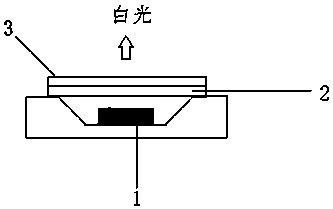A method for preparing fluorescent glass sheets for LED packaging by screen printing
A technology of LED encapsulation and screen printing, which is applied in the field of materials science, can solve problems affecting the quality and life of LED lamps, rapid aging, color drift, etc., to reduce the occurrence of fluorescent dead spots, good heat dissipation performance, and high temperature The effect of stable luminous performance
- Summary
- Abstract
- Description
- Claims
- Application Information
AI Technical Summary
Problems solved by technology
Method used
Image
Examples
Embodiment 1
[0017] (1) Press the set amount B 2 O 3 , SiO 2 , Na 2 O, ZnO and TiO 2 The mole percentage of weighing B 2 O 3 , SiO 2 , Na 2 O, ZnO and TiO 2 The borosilicate glass matrix material, in which the mole percentage of each component of the glass matrix is: B 2 O 3 : 40%, SiO 2 : 10%, Na 2 O: 7%, ZnO: 30%, TiO 2 : 13%, and mix evenly.
[0018] (2) Put the ground mixture into a corundum crucible and melt it at 1100°C for 30-40 minutes, pour the resulting melt into distilled water for water quenching, dry, and ball mill to a glass with a particle size of 10-15μm Powder for use
[0019] (3) Preparation of glass paste containing phosphor, Ce: YAG powder occupies 2wt% of the total mass of the glass powder. The binder is terpineol and ethyl cellulose, the former accounts for 70wt% of the total mass of the glass powder, the latter accounts for 20wt% of the total mass of the glass powder, and the dispersant is polyacrylamide, which accounts for 8wt% of the total mass of the glass powder;
[00...
Embodiment 2
[0023] (1) Press the set amount B 2 O 3 , SiO 2 , Na 2 O, ZnO and TiO 2 The mole percentage of weighing B 2 O 3 , SiO 2 , Na 2 O, ZnO and TiO 2 The borosilicate glass matrix material, in which the mole percentage of each component of the glass matrix is: B 2 O 3 : 45%, SiO 2 :5%, Na 2 O: 8%, ZnO: 20%, TiO 2 : 12%, and mix evenly.
[0024] (2) Put the ground mixture into a corundum crucible and melt it at 1100°C for 40 minutes. Pour the resulting melt into distilled water for water quenching, dry, and ball mill to a glass powder with a particle size of 10~15μm. use;
[0025] (3) Ce: YAG powder accounts for 6wt% of the total mass of glass powder. The binder is terpineol and ethyl cellulose, the former accounts for 70wt% of the total mass of the glass powder, the latter accounts for 15wt% of the total mass of the glass powder, and the dispersant is polyacrylamide, accounting for 9wt% of the total mass of the glass powder;
[0026] (4) Stir the mixed slurry at 70-90°C for 30-60 minutes ...
Embodiment 3
[0029] (1) Press the set amount B 2 O 3 , SiO 2 , Na 2 O, ZnO and TiO 2 The mole percentage of weighing B 2 O 3 , SiO 2 , Na 2 O, ZnO and TiO 2 The borosilicate glass matrix material, in which the mole percentage of each component of the glass matrix is: B 2 O 3 : 35%, SiO 2 : 15%, Na 2 O: 9%, ZnO: 33%, TiO 2 : 8%, and mix evenly.
[0030] (2) Put the ground mixture into a corundum crucible and melt it at 1100°C for 40 minutes. Pour the resulting melt into distilled water for water quenching, dry, and ball mill to a glass powder with a particle size of 10~15μm. use;
[0031] (3) Ce: YAG powder accounts for 8wt% of the total mass of glass powder. The binder is terpineol and ethyl cellulose, the former accounts for 75wt% of the total mass of the glass powder, the latter accounts for 10wt% of the total mass of the glass powder, and the dispersant is polyacrylamide, accounting for 7wt% of the total mass of the glass powder;
[0032] (4) Stir the mixed slurry at 70-90°C for 30-60 minutes...
PUM
| Property | Measurement | Unit |
|---|---|---|
| particle diameter | aaaaa | aaaaa |
| thickness | aaaaa | aaaaa |
| thickness | aaaaa | aaaaa |
Abstract
Description
Claims
Application Information
 Login to View More
Login to View More - Generate Ideas
- Intellectual Property
- Life Sciences
- Materials
- Tech Scout
- Unparalleled Data Quality
- Higher Quality Content
- 60% Fewer Hallucinations
Browse by: Latest US Patents, China's latest patents, Technical Efficacy Thesaurus, Application Domain, Technology Topic, Popular Technical Reports.
© 2025 PatSnap. All rights reserved.Legal|Privacy policy|Modern Slavery Act Transparency Statement|Sitemap|About US| Contact US: help@patsnap.com


